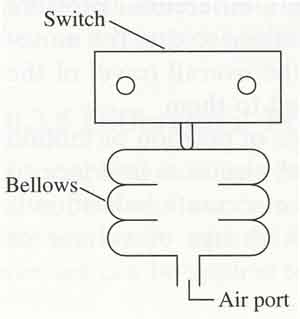 |
The bellows pressure sensor is made of a sealed chamber that has multiple ridges like the pleats of an accordion that are compressed slightly when the sensor is manufactured. When pressure is applied to the chamber, the chamber will try to expand and open the pleats. The figure on the left shows an example of a bellows sensor, which uses a spring to oppose the movement of the bellows and provides a means to adjust the amount of travel the chamber will have when pressure is applied. In low-pressure bellows sensors, the spring is not required. The travel of the bellows can be converted to linear motion so that a switch can be activated, or it can be connected Io a potentiometer. This type of sensor is used in low-pressure applications usually less than 30 psi. The bellows sensor is also used to make a differential pressure sensor. In this application two bellows are mounted in a housing so that the movement of each bellows opposes the other. This will cause the overall travel of the pair to be equal to the difference of pressure that is applied to them. |
All of the foregoing pressure sensors provide a change of position or motion as pressure changes. This type of sensor limits the type of electrical interface to either an on/off switch or to a potentiometer. When a more accurate indication is required, other types of pressure sensors that produce a change of voltage or resistance will be used.
Prev. Page: Diff. Pressure Sensor | Next Page: Strain Gauges
Related pages: Load Cells | Flow Meters